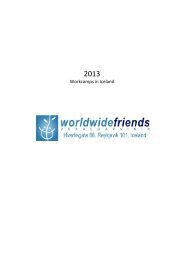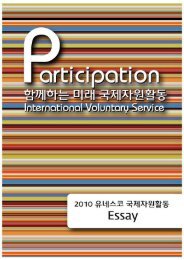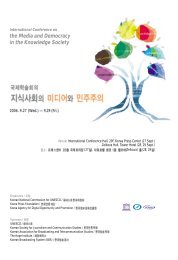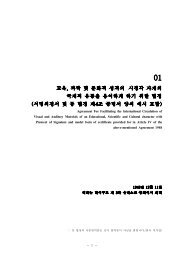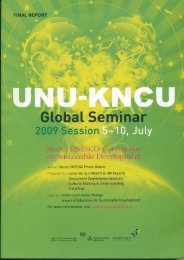íëìë³´ë2012문íì ë°ì ë¼ì´ëí ì´ë¸.pdf - ì ë¤ì¤ì½íêµììí
íëìë³´ë2012문íì ë°ì ë¼ì´ëí ì´ë¸.pdf - ì ë¤ì¤ì½íêµììí
íëìë³´ë2012문íì ë°ì ë¼ì´ëí ì´ë¸.pdf - ì ë¤ì¤ì½íêµììí
Create successful ePaper yourself
Turn your PDF publications into a flip-book with our unique Google optimized e-Paper software.
continues unchecked. There must be assistance and measures that goes further. Of course, the<br />
ideal solution is to educate the poor out of poverty.<br />
Yet at a time when education is also becoming a “dependent variable,” an environment<br />
where people can continue to receive education is required for it to work. Such an<br />
environment can be created by means of “immigration” and “emigration,” and new habits can<br />
be formed under a new educational environment. However, this approach denies the<br />
recipients of their cultural diversity and is not sustainable.<br />
In the end, the necessity for cultural perspective and strategy is to find “a practical way of<br />
thinking that acknowledges the cultural diversity of each region and that can overcome<br />
poverty at the same time.” In other words, it is about finding new and creative cultural<br />
elements that can help overcome poverty. This raises a fundamental question: What exactly is<br />
culture?<br />
1) Cultural Approach to Poverty<br />
Many researchers explain culture based on their own concepts and background knowledge.<br />
However, cultures differ greatly according to historical, institutional, political and<br />
geographical factors, which make it very difficult to define what it is. Culture does not exist<br />
on its own; it is influenced by a number of factors such as politics, economy, nature, and<br />
history. In the context of poverty research, Dakson and Binns (2010) thought that culture is<br />
closely connected with sustainable livelihood, because livelihood is influenced by traditional<br />
customs, knowledge, beliefs, technologies, social institutions, languages, identities, and<br />
tangible heritage. Cahn (2002) also said that there is a strong connection between culture and<br />
livelihood, and that livelihood is only sustainable when it is within culture and traditions.<br />
Because factors such as risk, vulnerability, resources, livelihood strategies, politics, gender<br />
roles, personal relationships, and social norms are affected by culture, sustainable livelihood<br />
patterns are created through social traditions and customs.<br />
To summarize, culture is a mix of components that includes values, communication, and<br />
symbolism, as well as a way of life that is influenced by said components. It provides<br />
strategies for survival as well as livelihood choices and opportunities based on available<br />
resources. It influences group behavior; and is passed from one generation to another<br />
(Kulatunga, 2010). Nonetheless, programs are still enacted that are doomed to fail due to a<br />
lack of understanding of cultural variables and inadequate response to development. There<br />
are numerous instances where public facilities are installed in unnecessary places and school




